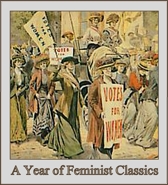 Reviewed by Christina
Reviewed by Christina(First, a note: In just a couple of weeks, my family will be welcoming a Redbone Coonhound puppy! I'm so excited I can hardly contain myself, and I've been reading about puppy/dog training nonstop. So naturally, I had to check out my breed's most famous representation in popular culture, Where the Red Fern Grows.)
Published: 1961
It's about: Ten-year-old Billy lives on a small family farm in northeastern Oklahoma, and the thing he wants most in the world is a pair of good coonhounds. His family are poor and can't afford the expense of two purebred puppies, so Billy secretly works and saves for two years until finally he can buy them himself. He works tirelessly to train the pups, and they quickly become his closest friends. Old Dan and Little Ann, as they're called, grow up to be exceptionally fine coonhunting dogs.
Billy and his hounds encounter success, adventure, and tragedy in this classic children's novel.
I thought: First of all, let me just say that I would have LOVED this book if I had read it as a kid. I know I would have sobbed at the ending and subsequently begged my parents for a farm in the Ozarks and two puppies. But reading it as an adult, I found my reaction to be a bit more reserved, and I'm having some trouble organizing my thoughts. As usual, I seem to have more questions than firm opinions.
Right from the beginning, I was surprised at how emotional Billy was. It seems his first reaction to almost every event, positive or negative, is to cry. Honestly, there are at least 15 mentions of Billy crying in this short book. I too have always expressed myself mainly through tears. But I grew up with three brothers who didn't cry nearly as easily, especially not when they were Billy's age- ten to fourteen or fifteen years old. Is this a sign of the changing times? Is it more unacceptable now for boys to cry than when this story takes place in the early part of the twentieth century? What about in the early '60's when it was written? Or I am over thinking this? Is Billy just an unusually tearful boy?
Speaking of crying, the parts that had the strongest emotional effect on me were Billy's interactions with his parents and grandparents, and I'm sure I wouldn't have been as sensitive to those aspects of the story if I were a part of the intended audience (children). His family loves and respects Billy so much, and they want him to have everything he wants; in some ways, Billy has an ideal family situation. But their circumstances just don't allow for Billy to be spoiled or coddled in any way, which was heartbreaking to read. And I couldn't help but notice Billy's relationship with his mother. He clearly loves her and can't bear to make her worry, but he also believes he knows better than her in most situations, and he occasionally lovingly condescends when he speaks to her. I imagine this is the same attitude a good boy like Billy would eventually have toward his wife, and I'm guessing it's indicative of the attitude toward women in his world (and possibly in Wilson Rawls' world, too). Billy's three sisters are uniformly silly and fearful, so there really is no strong female presence in his life. I wonder if I would have noticed that if I'd read this when I was in elementary school.
Another interesting aspect of Where the Red Fern Grows that I wouldn't have cared about as a kid was the socio-economic backdrop of rural Oklahoma. Billy's hardworking but uneducated parents are smart but also superstitious, and they believe in Christian prayer-answer principles with a hint of Native American legend.
Oh boy, this review is getting too long and I still have lots more to say. Briefly: the writing is good- Billy's voice and the dialogue are fittingly old-timey. He uses lots of cleverly childish similes for physical manifestations of emotion ("My stomach felt like something alive was crawling in it.") There is a LOT of hunting, something I'm not interested in at all, but I still felt it was well-paced.
Verdict: I wish I had read it as a kid, so stick it on that there shelf!
Reading Recommendations: Definitely pick this one up if you are 9-13 years old.
Warnings: Some mild violence, mostly toward raccoons.
Favorite excerpts:
"Even though it was a great sacrifice, I told Papa I had decided I didn't want two hounds. One would be enough. I saw the hurt in his eyes. It made me feel like someone was squeezing water out of my heart."
What I'm reading next: Ahab's Wife: or, the Star-Gazer by Sena Jeter Naslund








